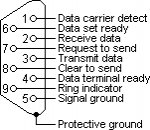I am looking at an HMI screen that operates off of 24VDC. On the back connector there is a "+" a "-" and a ground symbol enclosed in a circle. When I connect all pos. neg. and a ground wire to the connector, everything operates as expected. The ground wire connected to the ground terminal at the HMI side, and then to safety ground on the panel side. The ground terminal is also internally connected to the frame of the HMI.
When I plug in a DB-9 (RS232), things get interesting. With the DB-9 installed and the ground wire installed, my power supply powering the HMI is now ground referenced instead of floating.
I can kind of see how the signal ground on the RS232 is interacting with the frame ground. But, I do not see how this is grounding the "-" of my power supply. Any thoughts on how the "-" terminal is being connected here?
When I plug in a DB-9 (RS232), things get interesting. With the DB-9 installed and the ground wire installed, my power supply powering the HMI is now ground referenced instead of floating.
I can kind of see how the signal ground on the RS232 is interacting with the frame ground. But, I do not see how this is grounding the "-" of my power supply. Any thoughts on how the "-" terminal is being connected here?

